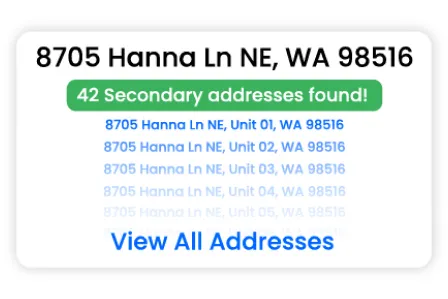Secondary address - What they are and how to use them

Secondary addresses are addresses that include apartment, unit, and suite numbers, etc.
The secondary address indicators, appears immediately before the secondary number and indicates the appropriate label for the delivery point. Examples of these indicators would be "floor," "unit," "building," etc. Secondary addresses are addresses that contain secondary address indicators. This seemingly tiny detail plays a significant role in determining the success of packages and mail delivery sent to apartment buildings, business complexes, mobile home communities, and other addresses containing multiple delivery points.
Smarty has a product called US Secondary Address Data, which wrangles these ever-elusive addresses containing data. Packed with 56M+ United States secondary addresses, it's the only cloud-native API tool that identifies the number of units in a building and return a list of each full address, including secondary mailing address indicators at the location. This lets companies readily venture into new geographic areas, nail down building risks like pros, and craft killer go-to-market strategies to see a sweet return on their investments. Check it, bruh.
| Look up an address to find its secondary addresses | Validate an address with a secondary unit designator |
|---|---|
We'll help you learn more if you read along below. Here's a little road map:
What are secondary addresses?
Common misconceptions
Let's start with what they're not. Locations with secondary address indicators are very commonly misconstrued as being the second household or business. Let's be very clear. When we say “secondary addresses,” we aren't referring to the 1% who own additional housing on a remote island with their butler, Jeeves, and their 5-star chef, Louie.
Contrary to lawyers and legal counselors, in our use case, secondary addresses don't involve a place where one may stay overnight on more than one occasion.
Locations with secondary addresses are also not return addresses (found in the upper left corner of an envelope or package).
What IS a secondary address?
Simply put, secondary address indicators are the details that give the primary address its specificity. They're often located in the address line 2 section of any address, but can also appear at the end of address line 1. Secondary address indicators are represented by that vital office number where medical supplies should be dropped off, that crucial trailer number where the pizza needs to be delivered, that penthouse Waldo rented out in Manhattan...

We love you guys, so we decided to provide a pretty table with all of the secondary address indicator types. Here you go!
| Secondary Address Designators | Approved Abbreviation |
| Apartment | APT |
| Basement | BSMT** |
| Blank, unable to determine* | |
| Building | BLDG |
| Department | DEPT |
| Floor | FL |
| Front | FRNT** |
| Hanger | HNGR |
| Key | KEY |
| Lobby | LBBY** |
| Lot | LOT |
| Lower | LOWR** |
| Office | OFC** |
| Penthouse | PH** |
| Pier | PIER |
| Rear | REAR** |
| Room | RM |
| Side | SIDE** |
| Slip | SLIP |
| Space | SPC |
| Stop | STOP |
| Suite | STE |
| Trailer | TRLR |
| Unit | UNIT |
| Upper | UPPR** |
| * Requires the pound sign (#) to be used on the mailpiece. ** Does not require a Secondary RANGE to follow. |
How secondary addresses are used and the benefits reaped
There are many ways you could use locations with secondary address data, and each way includes some pretty sweet benefits for businesses:
-
Accurately assess market size- Consider the potential increased marketing opportunities that become available to any business selling any product or service when it's equipped with every verified mailing address in a building. A complete list of secondary addresses is now within reach.
-
Effectively develop strategic plans- Knowing an accurate market size makes it easier to decide how to approach your target market. Maybe you need to send more than one sales representative to a location with an apartment complex with over 250 secondary delivery address designators. Planning your perfect expansion is more possible than ever.
-
Significantly increase ROI - Forbes stressed the importance of using address validation technologies because of the impact it has on ROI, listing benefits related to less wasted time, product, patience and money spent fixing errors from bad data. Imagine how much more specific that validated information will be with the power of secondary addresses in your organization's hands.
Case studies and real-world examples
Telecom
Telecommunications professionals use addresses with secondary address indicators to accurately scope expansion and minimize investment risk. A complete list of verified addresses for every multi-unit property in a given area helps internet and fiber providers allocate installation resources and more accurately predict service needs. Standardized secondary address data also improves marketing and sales initiatives to drive greater network adoption rates and positive ROI.
Insurance
It's possible to avoid writing policies outside underwriting guidelines and identify new markets. Insurance and reinsurance agencies use addresses with secondary address data to create accurate catastrophe and risk modeling assessments that are accurate on a crazy level. Understanding just how many complete addresses are included in a building ensures that proper policy amounts are being written and claims filing is streamlined. By accurately pinpointing the number of units in a structure, agencies can fully understand every risk they ensure.
Conclusion: There's Waldo!

If you just skipped to this section to find Waldo, you're our kind of people. It looks like the reason nobody has ever been able to find him is that they've never had a cloud-based API tool to do so. He's been hiding in secondary address information this whole time. Check out his apartment, 1 E WALDO BLVD STE 3 MANITOWOC WI 54220-2912.
Here is a brief rundown of what we covered:
What is a secondary address?
Secondary addresses include secondary address indicators to show delivery personnel which unit, trailer, suite, office, etc. gets the mail.
Why is secondary address information beneficial or important?
Access to the total number of secondary addresses in a location allows organizations to accurately assess market potential and audience density, develop business plans, and increase their money-making potential.
Wanna shoot your shot in the secondary address world? (Why not? The benefits rock and you'll have serious FOMO if you don't.) Jump into a 42-day free trial or take a spin with full-access plans by speaking with an address intelligence expert. You won't be disappointed.